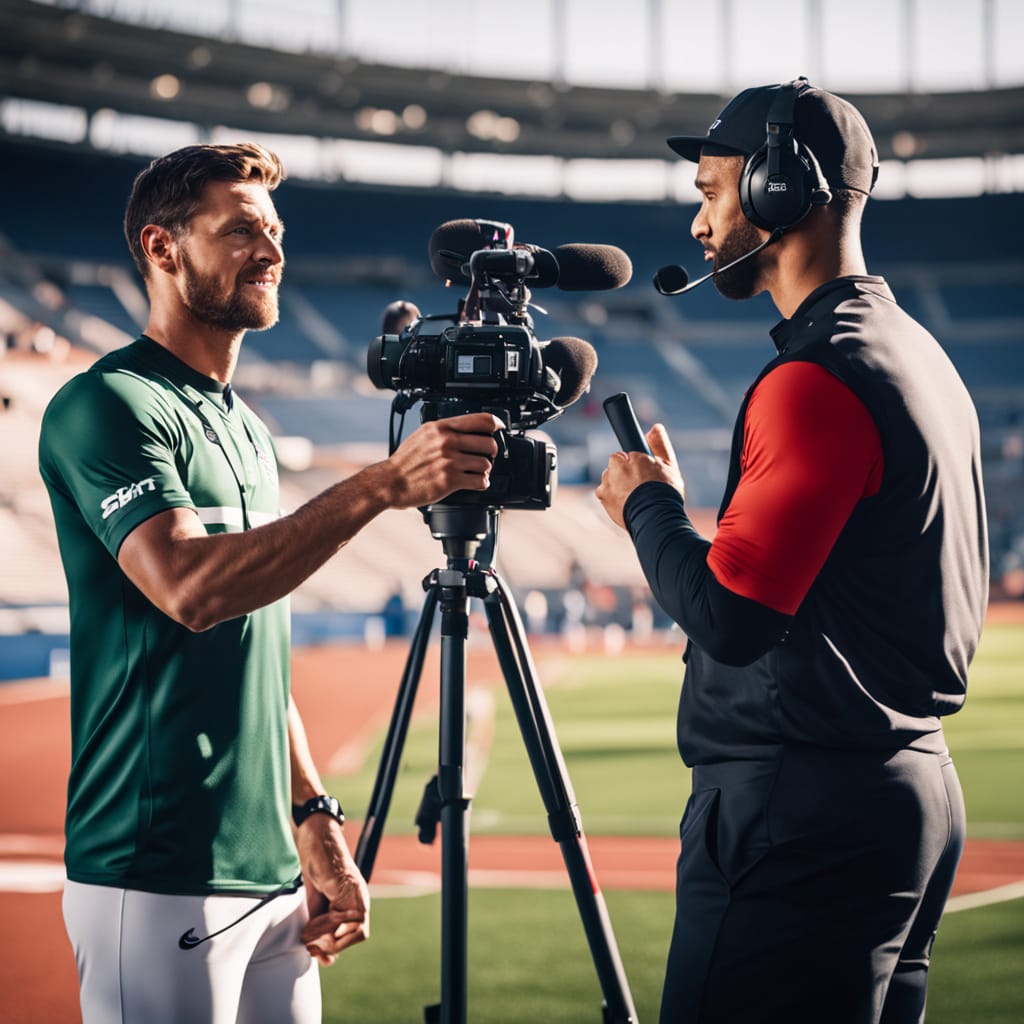The Media’s Impact on Sports
The Media’s Impact on Sports: A Comprehensive Look

The relationship between sports and media has evolved over the years. Today, it’s impossible to separate the two. The media’s impact on sports has shaped how fans engage with their favorite teams, players, and events. With media platforms continuously evolving, sports consumption has transformed from attending games in person to enjoying them across a variety of devices. The rise of digital platforms and social media has further expanded the scope, bringing sports closer to fans worldwide. In this post, we will explore what the media is, its historical role in sports, its influence across different countries, its positive and negative impacts, and the future it holds for the sports world.
What is Media?
Before diving into the media’s role in sports, it’s essential to understand what the media is. In broad terms, media refers to the means of communication that reach large audiences. These can range from traditional platforms such as newspapers, radio, and television, to newer formats like websites, podcasts, and social media channels. In sports, the media acts as a bridge between the athletes, teams, and fans. The relationship is mutually beneficial. The media gains content to generate revenue and engage their audience, while sports teams and athletes gain visibility, sponsorships, and fan support.
The role of media is not just limited to broadcasting games. It also includes analyzing performances, covering controversies, and providing an ongoing narrative around teams and players. These narratives have contributed to the growing popularity of sports across the globe. As a result, media plays an indispensable role in shaping the sports landscape.
The History of Media’s Involvement in Sports
The media’s relationship with sports can be traced back to the 19th century. Newspapers were among the first forms of media to cover sports events. In the late 1800s, local newspapers would dedicate sections to sports coverage. This trend expanded as sports like baseball, football, and boxing gained popularity. Fans would read reports on game results, match summaries, and player performance.
Radio soon entered the scene in the early 20th century, revolutionizing sports broadcasting. Fans could now follow live commentary of games without attending them. The invention of the radio enabled a more immediate connection between sports and the audience. This was especially important for fans who could not attend games in person. The live element added excitement, creating a more immersive experience for listeners.
The next major evolution came with television. In the 1950s and 1960s, sports broadcasting took off. Television allowed fans to watch live sporting events from the comfort of their homes. The visual element made the experience even more captivating. By the 1980s, sports television networks like ESPN emerged, offering 24/7 coverage of various sports.
The internet and digital media have revolutionized sports coverage over the past two decades. Streaming services, social media, and sports blogs have offered new ways for fans to engage. Today, fans can access live updates, highlights, interviews, and analysis through multiple platforms. Social media has also allowed athletes to communicate directly with their audience, bypassing traditional media outlets.
Media’s Impact on Sports in Different Countries
The media’s impact on sports is not uniform across the world. In different countries, the relationship between sports and media varies based on cultural and economic factors.
In the United States, sports media has an enormous influence. Major leagues like the NFL, NBA, MLB, and NHL rely heavily on media coverage to drive fan engagement and revenue. Television rights deals in these leagues often run into billions of dollars. Networks like ESPN and Fox Sports thrive on sports coverage, while online platforms like Bleacher Report and The Athletic provide in-depth analysis and updates. The media’s role extends beyond game-day coverage, with analysis shows, player interviews, and behind-the-scenes content dominating the airwaves.
In Europe, the media’s influence is heavily concentrated around football (soccer). Premier leagues such as the English Premier League (EPL), La Liga in Spain, and the Bundesliga in Germany have massive followings due to their extensive media coverage. Football clubs in these regions depend on media deals, as broadcasting rights are a significant source of revenue. Social media has amplified the interaction between European football clubs and their fanbases, allowing fans worldwide to stay connected. Other sports, like rugby and cricket, also enjoy substantial media attention in countries like the UK and India.
In Asia, cricket dominates media coverage in countries like India, Pakistan, and Sri Lanka. The Indian Premier League (IPL) stands out as one of the most valuable sports leagues globally, largely because of lucrative media rights deals. In contrast, countries like Japan focus more on baseball and sumo wrestling, while China’s sports media is more involved in promoting basketball and football. Social media platforms like Weibo in China and Twitter in India play pivotal roles in sports coverage, allowing fans to engage in real-time discussions and access live updates.
In Africa, media coverage of sports is mainly concentrated on football. Major leagues in South Africa, Nigeria, and Egypt attract significant local attention. Pan-African sports channels like SuperSport and various online platforms have helped local fans stay connected to both African leagues and international competitions. Although the media’s influence is growing, there is still room for expansion in the African sports media market.
Positive Impacts of Media on Sports
The media has undoubtedly had a positive impact on sports. One of the most significant benefits is increased visibility for various sports and athletes. Without media coverage, sports like swimming, gymnastics, or track and field might not gain the attention they receive during major events like the Olympics. Media platforms provide athletes with a chance to gain global recognition, even in sports that aren’t as mainstream.
Another positive impact is financial growth. Media rights deals have become a crucial revenue stream for sports leagues, teams, and athletes. For instance, the NFL and the English Premier League have signed multi-billion-dollar deals with broadcasters, enabling teams to invest in better infrastructure, training facilities, and player development. Athletes benefit through sponsorship deals and endorsements that come with media exposure.
Fan engagement is another area where the media has positively influenced sports. Through live broadcasts, social media interactions, and sports podcasts, fans feel more connected to their favorite athletes and teams. Social media has created a two-way conversation between fans and athletes, making the relationship more personal. This increased engagement has also led to larger fanbases and more diverse audiences, especially as sports media continues to expand to digital platforms.
Additionally, the media has played a critical role in bringing important sports stories to light. Through investigative journalism, issues such as doping, corruption, and gender inequality in sports have been addressed. These stories have pushed for reforms, raising awareness about issues that affect athletes and fans alike.
Negative Impacts of Media on Sports
While the media has had numerous positive effects on sports, it also has some negative impacts. One major issue is the commercialization of sports. Media companies often prioritize profits over the purity of the game. Advertisements, sponsorships, and product placements sometimes overshadow the sporting event itself. In some cases, broadcasters dictate the scheduling of games based on prime viewing times, disregarding athletes’ needs and concerns. This commercialization can detract from the authenticity of the sport.
Another negative impact is the pressure that media coverage places on athletes. The constant scrutiny can affect an athlete’s mental health and well-being. When athletes make mistakes, especially in high-profile games, the media can amplify these errors, leading to public criticism and even harassment. Social media exacerbates this issue, as fans can directly express their opinions about an athlete’s performance, sometimes in harmful ways.
Media bias also poses a challenge. In some instances, media outlets may focus disproportionately on certain teams, players, or sports based on their popularity. This can lead to less coverage for smaller teams or minority athletes, creating an imbalance in the exposure they receive. Moreover, sensationalism in sports reporting can distort facts or create unnecessary controversies. Rather than focusing on the game, media outlets may highlight trivial incidents or off-field issues to attract viewership.
Finally, with the rise of digital platforms, there is a growing issue of misinformation in sports reporting. Fake news and rumors can spread quickly through social media, leading to misunderstandings or damage to an athlete’s reputation. The media’s desire to be first to break a story often compromises accuracy, further contributing to this issue.
The Media’s Obligation to Fair and Accurate Reporting
The media’s responsibility to provide fair and accurate reporting in sports is vital. Given the media’s massive influence, it holds the power to shape public perception. As such, media outlets must ensure that they report on sports events, athletes, and controversies with integrity and impartiality.
Journalists have an ethical obligation to fact-check their stories before publishing them. Inaccurate reporting can tarnish reputations, hurt teams, and damage the integrity of the sport. The media should also strive for balance in their coverage. They need to cover all teams, athletes, and sporting events fairly, avoiding any favoritism or bias.
Moreover, when reporting on sensitive issues, such as injuries or personal matters, the media should approach the story with respect for the athlete’s privacy. They must recognize that athletes are human and can experience emotional and mental struggles. Over-sensationalizing or prying into personal matters for viewership purposes is unethical and can harm the individual.
The Future Impact of Media on Sports
Looking ahead, the media’s impact on sports will only grow. With the rise of streaming services, fans can now watch games from anywhere in the world. This trend will likely continue as more media companies invest in digital platforms. This shift will further democratize sports viewership, allowing even niche sports to find dedicated audiences online.
Social media will continue to shape how fans engage with sports. Platforms like Twitter, Instagram, and YouTube provide athletes with direct communication channels to their fans. Athletes will increasingly manage their own media presence, becoming influencers in their own right. This new level of access will deepen the fan-athlete relationship and likely blur the lines between sports and entertainment.
Furthermore, virtual reality (VR) and augmented reality (AR) technologies have the potential to transform the way fans experience sports. Imagine being able to attend a football match from your living room or watch a tennis match from a player’s perspective. These innovations will revolutionize fan engagement and offer new ways for media companies to deliver immersive sports experiences.
As artificial intelligence (AI) and data analytics continue to evolve, media coverage will become more personalized. AI could recommend specific matches, player stats, or sports-related news based on individual preferences. This will enhance the fan experience, allowing audiences to engage with content that matters most to them.
However, with these advancements come challenges. The issue of misinformation will likely become more significant. As more content floods the internet, distinguishing between credible sources and fake news will be increasingly difficult. Media outlets will need to ensure they maintain journalistic standards, even in the face of rapid technological change.
Conclusion
The media’s impact on sports has been profound and continues to shape how we experience and engage with our favorite teams and athletes. From its humble beginnings in newspapers to the dynamic digital platforms of today, the media has revolutionized the world of sports. While the media has brought numerous benefits, including increased visibility, financial growth, and fan engagement, it has also introduced challenges such as commercialization, bias, and misinformation.
Moving forward, the relationship between sports and media will evolve with the advancement of technology. However, the media’s obligation to fair, accurate, and balanced reporting remains crucial. As fans, athletes, and media outlets navigate this changing landscape, one thing is certain: the media will continue to play a central role in the world of sports.






